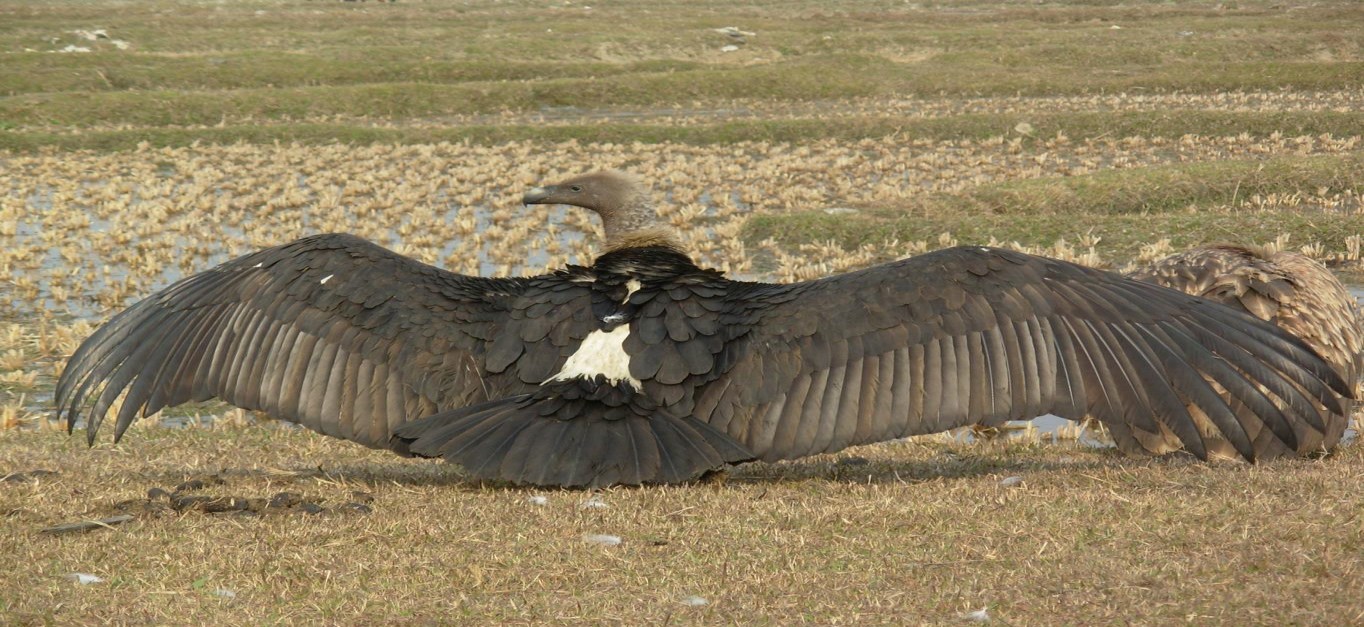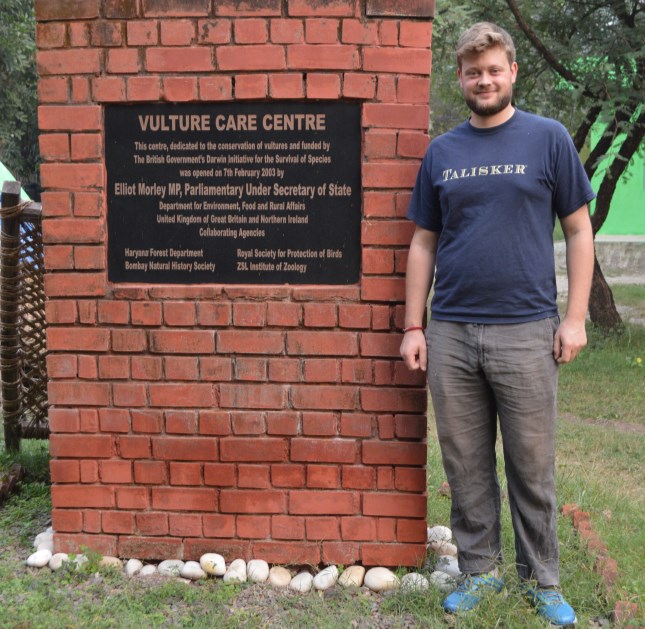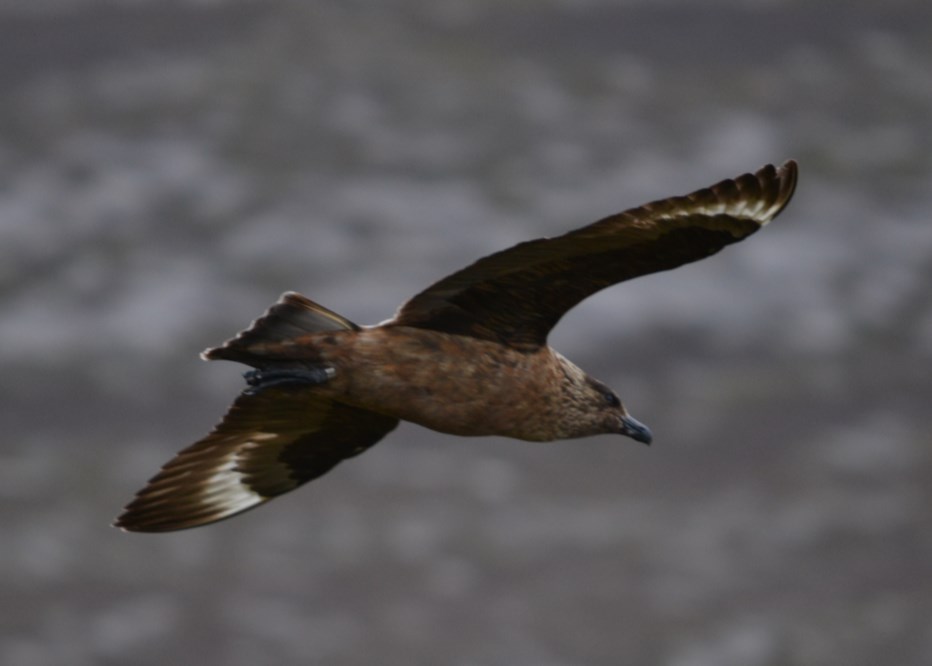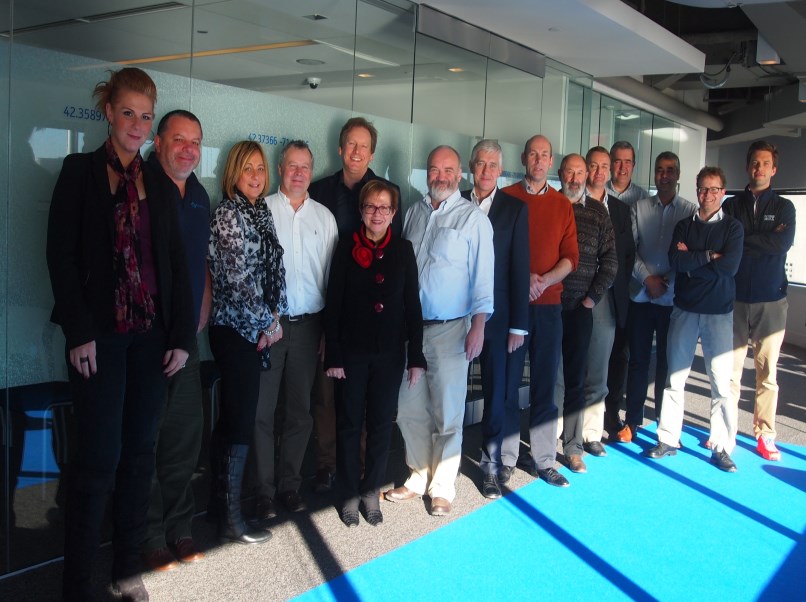Erionline.co.uk





Massive, Majestic and Magnificent
With a wingspan in excess of 10 feet in some species, Old World Gyps vultures are not only massive, majestic and magnificent birds, they are also nature's perfect carcass disposal system.
Sadly, of the eight Gyps species that exist, six have undergone rapid population declines over recent years. Three Asian species are particularly imperil ed at the moment - and are listed as Critically Endangered by the IUCN. One of these, the Oriental white backed vul-ture (Gyps bengalensis—pictured) was probably the most common bird of prey in the world in the mid 1980's.
As a member of the SAVE (Stop Asian Vulture Extinc-tion) Research and Conservation Consortium, Dr Mark Taggart spent much of October at a Gyps vulture
Oriental white backed vulture (Gyps bengalensis)
breeding sanctuary in North West India (Pinjore), along
Photo: Richard Cuthbert (RSPB/WCS)
with MSc student Joss Ratcliffe.
Their visit to Bombay Natural History Society's facility enabled Mark and Joss to train local staff and un-dertake extractions of more than 2000 liver tissue samples, in collaboration with staff from the RSPB. The samples, to be analysed at ERI in 2015, are from carcasses of cow and buffalo (vulture lunch!) taken from sites across India; and wil provide critical information about the driving forces behind vulture de-clines in this region.
Unlike Africa, where vultures are being driven towards extinction by de-liberate poisoning and persecution, in Asia the cause is a rather inno-cent looking veterinary pharmaceutical – diclofenac. This non-steroidal anti-inflammatory drug (NSAID), from the same class as aspirin and ibu-profen, has been used extensively on domestic livestock to alleviate common conditions (e.g. lameness, mastitis) for many years. Unfortunately, if diclofenac is given to a cow or buffalo shortly before the animal dies, any drug residues remaining in the carcass are lethal to Gyps vultures. To protect rapidly falling vulture populations veterinary diclofenac was banned in 2006 (across the Indian sub-continent). The liver tissue extracts which Mark is set to analyse will help to determine
Joss Ratcliffe, MSc student
just "how much diclofenac is stil out there" – since the ban has been
only partially effective.
Recently published work (co-authored by Mark) has shown that the level of carcass contamination with diclofenac dropped by about 50% between 2006 and 2009. The hope is that the new extracts wil demon-strate an even greater reduction – one sufficient to allow the vulture populations to recover. However, in a bizarr
e twist of fate, in 2013 certain European countries (Spain, Italy and others) licensed diclofenac for
veterinary use! Vociferous protests by scientists and conservationists highlighted the irresponsibility of


doing this, especially in Spain, where more than 95% of Eu-rope's vultures reside, and where "muladares" (traditional carcass dumps) are stil widespread. As a result, the EU and the European Medicines Agency (EMA) convened a review in October 2014 to decide wheth-er to stop veterinary diclofenac use in Europe. ERI made a significant contribution to this process by publishing im-portant new findings in Conservation Biology which showed that flunixin (another NSAID) has already kil ed Gyps vul-tures in Spain.
In early December Mark joined an eminent group of interna-tional authors to call for a much more holistic "One Health
Approach to the use of Veterinary Pharmaceuticals". In the popular and prestigious journal Science, the group argued that the current system to prevent veterinary pharmaceuti-cals harming biota that are not actual y being treated (i.e. so-called "non- target" organisms) is currently failing.
Unfortunately, in mid-December, although the EMA confirmed that veterinary diclofenac does indeed repre-sent a real risk to European vultures, they did not specifically recommend a ban – instead, they simply high-lighted various "options" – better regulation; veterinary controls; clearer labelling and / or an outright ban.
For further information contact [email protected]
Seabirds and offshor
Collisions between birds and turbines are seen as one of the key impacts of offshore wind farms. A new review by the British Trust for Ornithology (BTO), and involving the ERI's Dr Elizabeth Masden, has provided better estimates of the proportions of seabirds that alter their flight paths to avoid colliding with turbines.
When planning offshore wind farms, it is important to derive robust estimates of the number of birds likely to collide with turbines in order to help the decision making process. Whilst most birds wil take action to avoid colliding, a pro-portion wil not. The review found that over 99% of seabirds were likely to alter their flight paths to avoid collision.
However, Dr Aonghais Cook, Research Ecologist at BTO, who led the study said "It is important not to get lulled into a false sense of security by these figures. Whilst 99% of birds may avoid turbines, collision may stil be a significant risk at sites with large numbers of birds. Furthermore, there are stil a number of key gaps in knowledge for some vulnerable species."
The review (see recent publications) also revealed species-specific differences in the way in which sea-birds respond to wind farms. A significant proportion of gannets wil avoid entering a wind farm, however, gulls are much less cautious and may even be attracted to the sites as a result of the foraging opportunities they offer. Despite this, once inside the wind farms even gulls seem to show a strong avoidance of the tur-bine blades. Whilst there are stil significant gaps in our knowledge of bird behaviour within offshore wind farms, this work represents a major step forward, helping to ensure decisions are based on the best availa-ble evidence.
For further information contact [email protected]

The Massachusetts Institute of Technology (MIT) is internationally renowned for its strong entrepreneurial drive and for excellence in scientific and technological education and research - 81 Nobel laureates have been affiliated with MIT. If the revenues of companies founded by alumni were combined they would rank as the eleventh largest economy in the world!
Professor Stuart Gibb was given the opportunity to visit MIT as part of a Highlands and Islands Enterprise's (HIE) delegation, a conse-quence of their membership of the ‘Industrial Liaison programme' through which over 200 of the world's leading companies and re-search institutes interact with MIT.
The group consisted of representatives from across the marine re-newable supply chain in Scotland. The Learning Journey was led by Calum Davidson, Director of Energy and Low Carbon (HIE), and Norma Hogan, their Senior Development Manager. The group was
Delegation from Highlands and Islands hosted by Marie-Teresa Vander Sande, a Senior Officer from the
Industrial Liaison Program at MIT.
The purpose of the visit was twofold - firstly, to highlight relevant early stage research and development in areas of direct interest to organisations from the North of Scotland. Secondly, the visit aimed to take dele-gates out of their "comfort zone" and encourage new types of networking, specifically to explore how the Scottish marine energy supply chain could cluster more effectively, and develop business and technology solutions across the region.
The Institute extends for over a mile along the northern bank of the Charles River with the group visiting the iShip Lab (innovative ship designs and tools for offshore energy industry) and the Sea Grant and Autono-mous Underwater Vehicle Laboratories. Interactive sessions covered topics as diverse as ‘Energy Storage for Wave and Tidal' and ‘'Disciplined Entrepreneurship' to ‘ Ocean Modelling and Simulation'. Whilst the Dalai Lama was also speaking at MIT at the same time, the two groups were unable to meet!
For further information contact [email protected]
ERI Student wins Conference Award
The 2014 UHI Research Conference was hosted by Moray College in the new Alexander Graham Bell Cen-tre. Every two years this event brings together researchers from all faculties of the UHI partnership. Student presentations, training sessions and social events followed keynote speeches by Prof Clive Mulholland and Prof Muffy Calder (Chief Scientific Advisor for Scotland) whilst Dr Heather Rea (Beltane Public Engagement Forum) encouraged discussion about research impact and public engagement. From the ERI, Dr Philippe Gleizon, Dr Roxane Andersen, Prof John McClatchey and PhD student Andrew Commin gave talks on their latest research.
Posters were presented by ERI students -Dave Braidwood, Joss Ratcliffe, Angela Creevy and Andrew French, who collected the con-ference prize for the best postgraduate student poster - "Environmental variability and an endoparasite in wild red deer (Cervus elaphus) in the Scottish Highlands: rainfall and liver fluke (Fasciola hepatica)". Highlighting the diverse range of research which is carried out across the UHI partnership, in both science and humanities, this conference brings a range of talents together and acts as a melting pot, stimulat-ing inter-disciplinary research, enabling problems to be shared and identifying novel approaches to contemporary research questions.
Enthusiastic discussion between
For further information contact phil ip.gil [email protected]
Forest-to-Bog Restoration Management
Forest-to-bog restoration management- processes for transforming affor-ested peat into healthy open bog - is an important part of peatland re-search at ERI. Blanket bogs are protected under the EU Habitats Di-rective so habitat restoration is one important outcome as is the improve-ment in the carbon capture function of the bog.
Restoration management is now well underway at Dyke Forest in the RSPB Forsinard Flows Reserve and involves a combination of blocking drains and removing trees. These are either harvested or mulched, de-pending on size – the smallest trees are mulched. Two methods of har-vesting are being used (standard and enhanced) which, in combination
Paul taking samples
with plough furrow blocking on selected plots, creates four different resto-ration treatments. These are replicated throughout the Dyke Forest.
My PhD research is looking at how forest –to– bog restoration affects water quality and includes sampling pore water, streams and rivers. It is important to know how this type of management affects the chemical water quality of stream and river ecosystems since high concentrations of nitrate, phosphate, zinc and aluminium can be detrimental to developmental stages of Atlantic salmon. Monitoring of pore water quali-ty gives an insight into the in-situ changes in water chemistry within the bog, which is an important source of stream water.
We also need to gain a better understanding of changes to the carbon cycle during restoration. To this end, I am measuring carbon losses throughout the aquatic pathway by sampling during high flow storm events as well as regularly from three streams at different locations. One stream has an afforested catch-ment, another drains from an intact bog and the final one has forest-to-bog restoration occurring within its catchment. Combing measurements of stream discharge with stream depth logging wil enable determi-nation of how many grams of carbon per year per m2 is lost from each catchment via stream water.
My most recent fieldwork has focused on collecting samples from streams and rivers which receive drain-age water from restoration sites. Samples from undisturbed ‘control' streams are used for comparison.
Harvesting and mulching work began in October 2014 and for three months I sampled every two weeks. I have now returned to monthly sampling to allow work on pore water to re-commence. During the winter months I intend to sample during high flow events, as (hopefully) there wil be some periods of heavy rain-fall during this time!
For further information contact [email protected]
International Conference on Ocean Energy
Dr Marie-Lise Schläppy, research fellow, was among representatives from the University of Highlands and Islands (UHI) who travelled to Halifax, Canada to participate in the International Conference on Ocean Energy (ICOE). Informing the marine renewable community about the newest de-velopments in resource assessment, technology designs and policy, this conference attracted over 350 delegates from across the globe including the Carbon Trust, Innovate UK, International Scotland, Highland and Is-lands Enterprise and the European Union. Information was shared in three formats: plenary sessions hosted by key players; presentations on specific themes and a more general exhibition area. UHI presented information about Marine Energy Research Innovation and Knowledge Accelerator (MERIKA) within the Scottish section which was well represented by companies such as Pelamis, EMEC and Meygen - the latter being awarded the ICOE 2014 Navigator prize for "most signifi-
Marie-Lise in Canada
cant advance" in ocean energy development.
Aiming to generate new collaborations, the Institute of Ocean Energy at Acadia University; Energies Marines at the College of the North Atlantic and the Nova Scotia Community College were singled out as institutions having many comple-mentary interests to ERI. Identifying potential partners is an important part of our work, allowing us to continue to build collaborations across Europe and the rest of the world. Together with colleagues from the Marine Renewable Energy group in UHI, ERI intends to apply for European funding to progress this area of research. The next ICOE is scheduled to take place in Edinburgh in 2016 which wil include a strong presence of ocean energy researchers from UHI.
For more information contact Marie-lise.schlä[email protected]
Recent Publications
Nwaishi, F., Petrone, RM., Price, JS and Andersen, R. (2015). Towards developing a functional-based approach for
constructed peatlands evaluation in the Alberta Oil Sands region, Canada. Wetlands. DOI: 10.1007/s13157-014-
0623-1
Braidwood, D. W., V. Morales, and M. F. Gardner. Werdermann's Plantae chilense at the Royal Botanic Garden
Edinburgh. Edinburgh Journal of Botany 71.03 (2014): 385-406.
Wilkinson, D. M., Creevy, A. L., Kalu, C. L., & Schwartzman, D. W. (2014). Are heterotrophic and silica-rich eukary-
otic microbes an important part of the lichen symbiosis? Mycology. DOI: 10.1080/21501203.2014.974084
A S C P Cook, E M Humphreys, E A Masden and N H K Burton (2014) Scottish Marine and Freshwater Science Vol-
ume 5 Number 16:The Avoidance Rates of Col ision Between Birds and offshore turbines ISBN 978 1 78412 912 5
(web only publication)
Shore, R.F., Taggart, M.A., Smits, J., Mateo, R., Richards, N., Fryday, S. (2014). Detection and drivers of exposure
and effects of pharmaceuticals in higher vertebrates. Royal Society Philosophical Transactions B 369, 20130570.
Cuthbert, R.J., Taggart, M.A., Prakash, V., Chakraborty, S.S., Deori, P., Gal igan, T., Kulkarni, M., Ranade, S.,
Saini, M., Sharma, A.K., Shringarpure, R., Green, R.E. (2014). Avian scavengers and the threat from veterinary phar-
maceuticals. Royal Society Philosophical Transactions B 369, 20130574.
Meharg, A.A., Wil iams, P.N., Deacon, C.M., Norton, G.J., Hossain, M., Louhing, D., Marwa, E., Lawgalwi, Y., Tag-
gart, M.A., Cascio, C., Haris, P. (2014). Urinary excretion of arsenic following rice consumption. Environmental Pol-
lution 194, 181-187.
Student Placement
Alex Craine (University of Glasgow, MSc Veterinary Biosciences stu-dent) is currently undertaking her placement year at the ERI. As part of the Highland Red Deer Project, Alex has been working with Dr Mark Taggart to quantify liver fluke infection rates in deer and to de-velop a liquid chromatography-mass spectrometry (LC-MS/MS) methodology to measure endogenous hormone levels. A method to detect cortisol, cortisone, corticosterone, 11k, estrone and progester-one is being optimised for use on faeces and other sample types. This may allow stress-related hormone levels to be quantified in rela-tion to (for example) deer sex, age, parasite load and other environ-mental factors. Alex is also discussing additional research options
with the NHC equestrian school to look at selenium nutrition and vitamin E levels in horses on differing diet and exercise regimes. Deficiencies in selenium and/or vitamin E in horses may be detrimental to (amongst other things) reproduction, immunity, and nerve and muscle function. For further information contact [email protected]
New Fac e at ERI
Ainoa Pravia, PhD student
I am a biologist but I have always been very keen on entomology and
conservation. I graduated from the University of Oviedo, Spain and then
undertook a Masters' degree in Wildlife Conservation at Napier Univer-
sity, Edinburgh. I have been lucky enough to work in a few different
countries on diverse projects, mostly involving radio-tracking of wild ani-
mals. In Scotland I have worked for the Scottish Wildlife Trust and as
an Osprey Protection Officer at Loch of the Lowes, Dunkeld.
My PhD wil focus on assessing peatland management and identifying
trade-offs between restoration approaches for either carbon storage or
biodiversity. It will be very exciting as it gives me the chance to work
with invertebrates, and even though I am based at the James Hutton Institute in Aberdeen, I wil also spend a fair amount of time at ERI. For further information contact [email protected]
ERI Seminar Series
The ERI Seminar Series is sponsored by SSE Renewables. Seminars are held
monthly at ERI, Castle Street Thurso; they are free and open to EVERYONE
See eri.ac.uk for details
Environmental Research Institute
Centre for Energy & Environment,
Castle Street, Thurso,
North Highland College UHI, Thurso,
Caithness, KW14 7JD, Scotland
Caithness, KW14 7EE, Scotland
Tel: +44 (0) 1847 889589
Tel: +44 (0) 1847 889000
Fax: +44 (0) 1847 890014
Fax: +44 (0) 1847 889001
Email: [email protected]
Web: www.eri.ac.uk
Source: http://www.erionline.co.uk/resources/newsletter_Winter%202014_2015.pdf
NCFE Level 2Certificate in Understanding the Safe Handling of Medication in Health and Social Care Section 1: Understand medication and prescriptions This section will introduce the types of medicine you will come across in the work environment. You will also look at legislation and guidance about medicines. The different types of medicine available and why they
Microbiology (2002), 148, 1003–1013 Printed in Great Britain Metabolic engineering of lactic acid bacteria,the combined approach : kinetic modelling,metabolic control and experimental analysis Marcel H. N. Hoefnagel,1,2 Marjo J. C. Starrenburg,1,3 Dirk E. Martens,1,2Jeroen Hugenholtz,1,3 Michiel Kleerebezem,1,3 Iris I. Van Swam,1,3Roger Bongers,1,3 Hans V. Westerhoff4 and Jacky L. Snoep4,5











